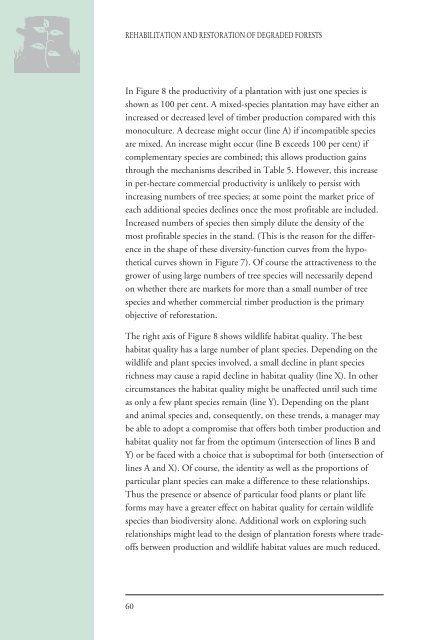Rehabilitation and Restoration Of Degraded Forests (PDF) - IUCN
Rehabilitation and Restoration Of Degraded Forests (PDF) - IUCN
Rehabilitation and Restoration Of Degraded Forests (PDF) - IUCN
Create successful ePaper yourself
Turn your PDF publications into a flip-book with our unique Google optimized e-Paper software.
REHABILITATION AND RESTORATION OF DEGRADED FORESTS<br />
In Figure 8 the productivity of a plantation with just one species is<br />
shown as 100 per cent. A mixed-species plantation may have either an<br />
increased or decreased level of timber production compared with this<br />
monoculture. A decrease might occur (line A) if incompatible species<br />
are mixed. An increase might occur (line B exceeds 100 per cent) if<br />
complementary species are combined; this allows production gains<br />
through the mechanisms described in Table 5. However, this increase<br />
in per-hectare commercial productivity is unlikely to persist with<br />
increasing numbers of tree species; at some point the market price of<br />
each additional species declines once the most profitable are included.<br />
Increased numbers of species then simply dilute the density of the<br />
most profitable species in the st<strong>and</strong>. (This is the reason for the difference<br />
in the shape of these diversity-function curves from the hypothetical<br />
curves shown in Figure 7). <strong>Of</strong> course the attractiveness to the<br />
grower of using large numbers of tree species will necessarily depend<br />
on whether there are markets for more than a small number of tree<br />
species <strong>and</strong> whether commercial timber production is the primary<br />
objective of reforestation.<br />
The right axis of Figure 8 shows wildlife habitat quality. The best<br />
habitat quality has a large number of plant species. Depending on the<br />
wildlife <strong>and</strong> plant species involved, a small decline in plant species<br />
richness may cause a rapid decline in habitat quality (line X). In other<br />
circumstances the habitat quality might be unaffected until such time<br />
as only a few plant species remain (line Y). Depending on the plant<br />
<strong>and</strong> animal species <strong>and</strong>, consequently, on these trends, a manager may<br />
be able to adopt a compromise that offers both timber production <strong>and</strong><br />
habitat quality not far from the optimum (intersection of lines B <strong>and</strong><br />
Y) or be faced with a choice that is suboptimal for both (intersection of<br />
lines A <strong>and</strong> X). <strong>Of</strong> course, the identity as well as the proportions of<br />
particular plant species can make a difference to these relationships.<br />
Thus the presence or absence of particular food plants or plant life<br />
forms may have a greater effect on habitat quality for certain wildlife<br />
species than biodiversity alone. Additional work on exploring such<br />
relationships might lead to the design of plantation forests where tradeoffs<br />
between production <strong>and</strong> wildlife habitat values are much reduced.<br />
60

















